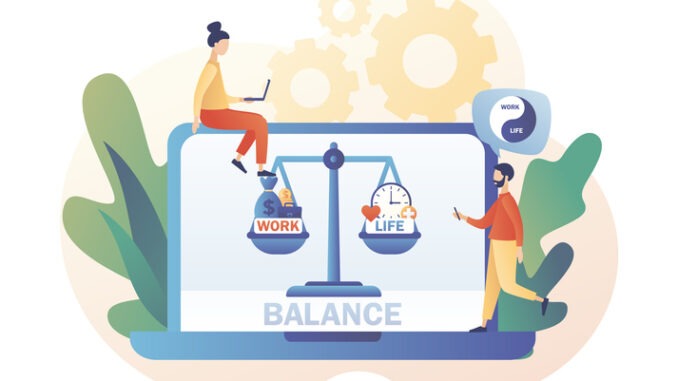
As the working landscape continues to change, Bonnie Evie Gifford explains how you and your partner can live a happy work-life balance, even with different work-life priorities
CREDIT: This is an edited version of an article that originally appeared on Happiful
Achieving a healthy work-life balance is tricky. Research shows that more than half of UK employees admit that work regularly eats into their personal life and, worldwide, the UK ranks 11th for work-life balance, with the average worker putting in 22 days of unpaid overtime each year.
This is bad enough, but what happens when our work-life balance isn’t only affecting us, but also others in our lives – and what can you do when you and your partner have very different priorities?
My partner and I are very much in opposite camps regarding what feels like a healthy work-life balance. I’m happy to jot down a few ideas outside of working hours and I’m pretty strict about switching off; my partner, on the other hand, would have continued taking work calls on our wedding day if someone hadn’t confiscated his ‘phone! If you’re worried that your relationship may be affected by your different attitudes to work and life, there are plenty of small changes you can make to help take the pressure off.
Talk it out
Sitting down to have an open, honest and frank conversation should be one of your first steps. This can help to make sure that you’re on the same page because what may feel like completely reasonable behaviour to one of you may be causing unnecessary stress, anxiety or resentment for the other. No matter how close you are, you both need to remember that your partner is not a mind reader; they may not know something is wrong if you don’t tell them.
Negotiate boundaries
Once you’ve established which areas are causing issues, try and work out boundaries. An outright ban on out-of-hours emails may cause a build-up of stress that wasn’t there before, while ignoring the needs of your other half could cause frustration. By creating boundaries together, through discussions, you can establish what works for you both. Keep returning to these boundaries regularly to help judge if they are working as intended, or if there could be a better way to try things moving forward.
Discuss your shared goals
We each have very different driving motivations; some people are career-driven, while others find fulfilment outside of their work. It’s OK if your core values are different from your partner’s – there’s no right or wrong way to be – but gaining a clear awareness of what drives each of you can help you develop a better understanding of one another in the long term.
Let go of resentment
Staying angry or upset about your different work priorities can lead to resentment, further hurt feelings, frustration and misunderstandings. If you are aware of negative feelings continuing to linger or build, it could be a sign that you and your partner need to communicate better about your needs, boundaries and expectations. Holding onto negativity can only hurt you in the long run – but that doesn’t mean it should be brushed aside. Ensure that your partner understands how you are feeling, and work together to create a more positive, open space where you can talk.
Schedule us-time
Set time aside in your calendar for uninterrupted time with your partner. This might be something daily, like having a ‘phone-free breakfast together, or perhaps it’s deciding on a set number of evenings where you both agree to be present in the moment, without outside distractions. Switching off for agreed upon times can help you both to feel appreciated without allowing unnecessary anxiety or frustration to build.
Focus on quality, not quantity
Think about the time you are spending together. Do you feel relaxed, closer, refreshed? Or have you fallen into a slump? Ensuring the periods that you spend together are always used to their full potential can help you to better appreciate them, as well inspiring you both to feel excited at the prospect of more time together.


Be the first to comment